
What's Opera, Doc? is a 1957 American Warner Bros. Merrie Melodies cartoon directed by Chuck Jones and written by Michael Maltese. The short was released on July 6, 1957, and stars Bugs Bunny and Elmer Fudd.

Merrie Melodies is an American animated comedy short film series distributed by Warner Bros. Pictures. It was part of the Looney Tunes franchise and featured many of the same characters. It originally ran from August 2, 1931, to September 20, 1969, during the golden age of American animation, though it was revived in 1979, with new shorts sporadically released until June 13, 1997. Originally, Merrie Melodies placed emphasis on one-shot color films in comparison to the black-and-white Looney Tunes films. After Bugs Bunny became the breakout character of Merrie Melodies and Looney Tunes transitioned to color production in the early 1940s, the two series gradually lost their distinctions and shorts were assigned to each series randomly.
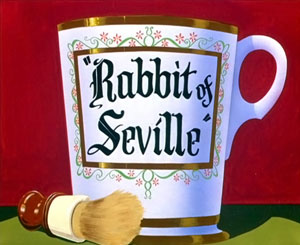
Rabbit of Seville is a Warner Bros. Looney Tunes theatrical cartoon short released on December 16, 1950. It was directed by Chuck Jones and written by Michael Maltese, and features Bugs Bunny and Elmer Fudd. The nonstop slapstick humor in the short is paced musically around the overture to Italian composer Gioachino Rossini's 1816 opera buffa The Barber of Seville. In 1994, Rabbit of Seville ranked number 12 in a list of "The 50 Greatest Cartoons" released in North America during the 20th century, a ranking compiled from votes cast by 1,000 artists, producers, directors, voice actors, and other professionals in the field of animation.

Hare Brush is a 1955 Warner Bros. Merrie Melodies animated short directed by Friz Freleng. The short was released on May 7, 1955, and stars Bugs Bunny and Elmer Fudd.
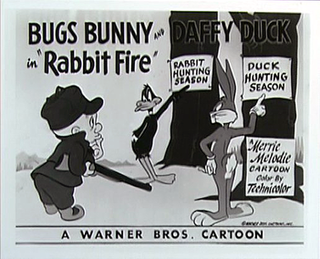
Rabbit Fire is a 1951 Looney Tunes cartoon starring Bugs Bunny, Daffy Duck, and Elmer Fudd. Directed by Chuck Jones and written by Michael Maltese, the cartoon is the first in Jones' "hunting trilogy"—the other two cartoons following it being Rabbit Seasoning and Duck! Rabbit, Duck! It is also the first cartoon to feature a feud between Bugs and Daffy. Produced by Edward Selzer for Warner Bros. Cartoons, the short was released to theaters on May 19, 1951 by Warner Bros. Pictures and is often considered among Jones' best and most important films.

Elmer's Pet Rabbit is a 1941 Warner Bros. Merrie Melodies cartoon directed by Chuck Jones. The short was released on January 4, 1941, and features Elmer Fudd and Bugs Bunny.

Elmer's Candid Camera is a 1940 Warner Bros. Merrie Melodies cartoon short directed by Chuck Jones. The short was released on March 2, 1940, and features Elmer Fudd and an early Bugs Bunny prototype.
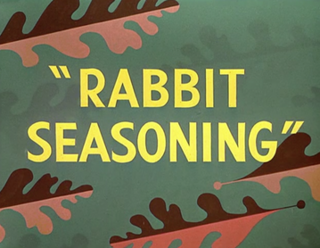
Rabbit Seasoning is a 1952 Warner Bros. Merrie Melodies cartoon directed by Chuck Jones. Released on September 20, 1952, the short stars Bugs Bunny, Daffy Duck and Elmer Fudd.

The Wabbit Who Came to Supper is a 1942 Merrie Melodies cartoon featuring Bugs Bunny and Elmer Fudd. It was released on March 28, 1942, and directed by Friz Freleng.

Hare Remover is a Merrie Melodies cartoon starring Bugs Bunny and Elmer Fudd, released in 1946. The film was the second Bugs Bunny cartoon to be directed by Frank Tashlin, the first being The Unruly Hare (1945).
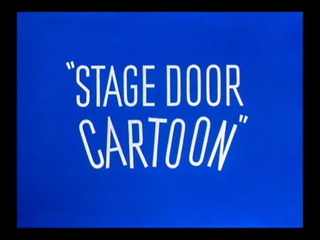
Stage Door Cartoon is a 1944 Merrie Melodies cartoon directed by Friz Freleng. The short was released on December 30, 1944, and features Bugs Bunny and Elmer Fudd.
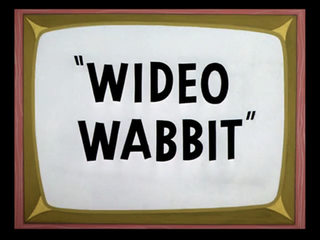
Wideo Wabbit is a 1956 Warner Bros. Looney Tunes cartoon directed by Robert McKimson. The short was released on October 27, 1956, and stars Bugs Bunny and Elmer Fudd. In the film, Bugs volunteers for an appearance in a television show hosted by Elmer. He is unaware that this is a show about hunting techniques, and he volunteers to become a hunter's prey.
Hare Splitter is a 1948 Warner Bros. Merrie Melodies animated short directed by Friz Freleng. The short was released on September 25, 1948, and features Bugs Bunny. The title is a play on "hair splitting", or focusing too much on fine details, reflecting how Bugs tries to "split up" Casbah and Daisy Lou so Bugs can date her himself.
Bugs Bunny's Thanksgiving Diet is an animated television special that aired November 15, 1979 on CBS. It stars Bugs Bunny and incorporated parts of several Looney Tunes cartoons. The special followed up on the successful Looney Tunes special Bugs and Daffy's Carnival of the Animals that had aired in 1976, which reintroduced the character of Bugs Bunny in his first new material since 1964.

The Hare-Brained Hypnotist is a Warner Bros. Merrie Melodies cartoon directed by Friz Freleng. The short was released on October 23, 1942 and features Bugs Bunny and Elmer Fudd. This cartoon's plot was re-worked for the cartoon Hare Brush (1955) and its opening music was re-used in Hair-Raising Hare (1946), The Super Snooper (1952) and Hyde and Hare (1955).
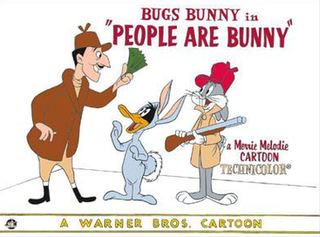
People Are Bunny is a 1959 Warner Bros. Merrie Melodies cartoon, directed by Robert McKimson The short was released on December 19, 1959, and stars Bugs Bunny and Daffy Duck.
This is a listing of all the animated shorts released by Warner Bros. under the Looney Tunes and Merrie Melodies banners between 1940 and 1949.
His Hare-Raising Tale is a 1951 Warner Bros. Looney Tunes short, directed by Friz Freleng and written by Warren Foster. The short was released on August 11, 1951, and stars Bugs Bunny and his nephew Clyde Rabbit.
Upswept Hare is a 1953 Warner Bros. Merrie Melodies cartoon directed by Robert McKimson. The cartoon was released on March 14, 1953, and stars Bugs Bunny and Elmer Fudd.














